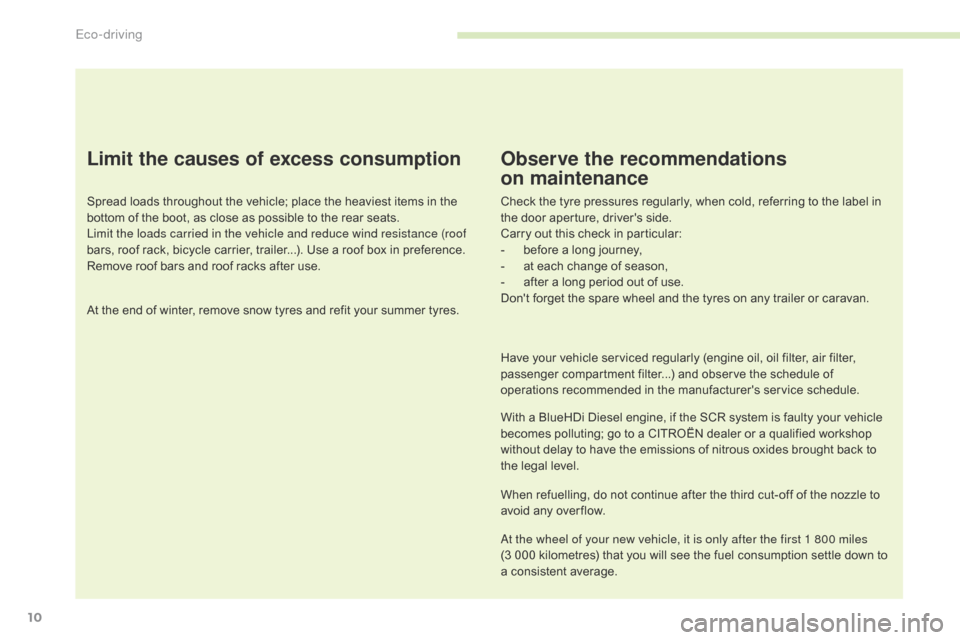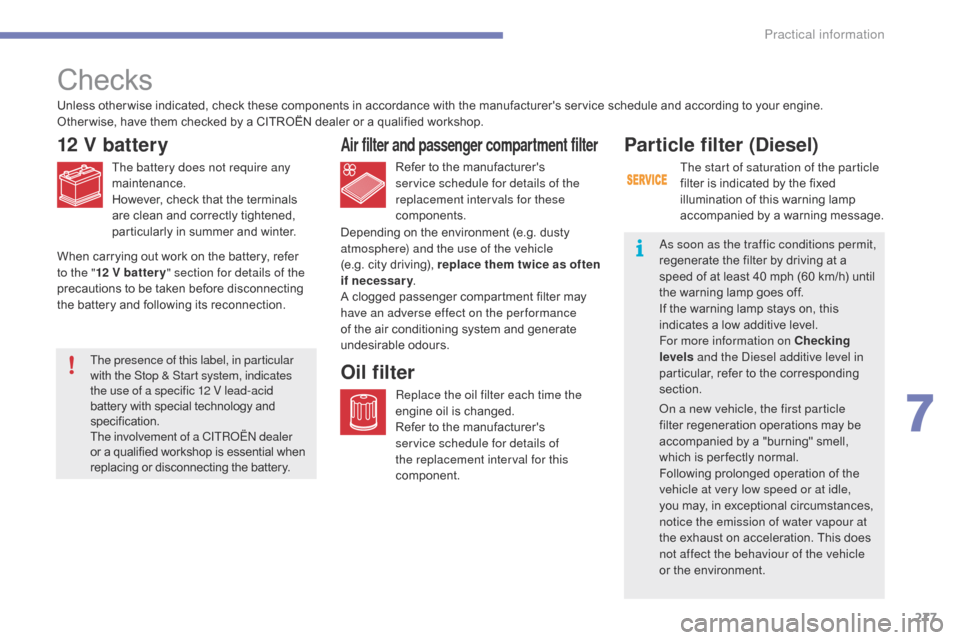maintenance schedule Citroen C4 PICASSO 2016 2.G Owner's Manual
[x] Cancel search | Manufacturer: CITROEN, Model Year: 2016, Model line: C4 PICASSO, Model: Citroen C4 PICASSO 2016 2.GPages: 527, PDF Size: 13.72 MB
Page 12 of 527

10
C4-Picasso-II_en_Chap00c_eco-conduite_ed01-2016
Limit the causes of excess consumption
Spreadô loadsô throughoutô theô vehicle;ô placeô theô heaviestô itemsô inô theô bottom ô of ô the ô boot, ô as ô close ô as ô possible ô to ô the ô rear ô seats.
Limit the loads carried in the vehicle and reduce wind resistance (roof
bars,
ô roof ô rack, ô bicycle ô carrier, ô trailer...). ô Use ô a ô roof ô box ô in ô preference.
Remove
ô roof ô bars ô and ô roof ô racks ô after ô use.
At
ô the ô end ô of ô winter, ô remove ô snow ô tyres ô and ô refit ô your ô summer ô tyres.
Observe the recommendations
on maintenance
Checkô theô tyreô pressuresô regularly,ô whenô cold,ô referringô toô theô labelô inô the ô door ô aperture, ô driver's ô side.
Carry
ô out ô this ô check ô in ô particular:
-
ô
b
efore ô a ô long ô journey,
-
ô
a
t ô each ô change ô of ô season,
-
ô
a
fter ô a ô long ô period ô out ô of ô use.
Don't
ô forget ô the ô spare ô wheel ô and ô the ô tyres ô on ô any ô trailer ô or ô caravan.
Have
ô your ô vehicle ô serviced ô regularly ô (engine ô oil, ô oil ô filter, ô air ô filter, ô
p
assenger ô compartment ô filter...) ô and ô observe ô the ô schedule ô of ô
o
perations ô recommended ô in ô the ô manufacturer's ô service ô schedule.
With
ô a ô BlueHDi ô Diesel ô engine, ô if ô the ô SCR ô system ô is ô faulty ô your ô vehicle ô
b
ecomes ô polluting; ô go ô to ô a ô CITROûN ô dealer ô or ô a ô qualified ô workshop ô
w
ithout ô delay ô to ô have ô the ô emissions ô of ô nitrous ô oxides ô brought ô back ô to ô
t
he ô legal ô level.
When
ô refuelling, ô do ô not ô continue ô after ô the ô third ô cut-off ô of ô the ô nozzle ô to ô
a
void ô any ô over flow.
At the wheel of your new vehicle, it is only after the first 1 800 miles
(3ô 000
ô kilometres) ô that ô you ô will ô see ô the ô fuel ô consumption ô settle ô down ô to ô
a
ô consistent ô average.
Eco-driving
Page 279 of 527

277
C4-Picasso-II_en_Chap07_info-pratiques_ed01-2016
Checks
12 V battery
The battery does not require any
maintenance.
However,ô check ô that ô the ô terminals ô
a
re ô clean ô and ô correctly ô tightened, ô
p
articularly ô in ô summer ô and ô winter.Refer
ô to ô the ô manufacturer's ô s
ervice schedule for details of the
replacement intervals for these
components.
Air filter and passenger compartment filter
Replace the oil filter each time the
engine ô oil ô is ô changed.
Refer
ô to ô the ô manufacturer's ô
s
ervice schedule for details of
the replacement interval for this
component.
Oil filterThe presence of this label, in particular
with the Stop & Start system, indicates
the use of a specific 12 V lead-acid
battery
ô with ô special ô technology ô and
ô s
pecification.
ô T
he involvement of a CITROûN dealer
or
ô a ô qualified ô workshop ô is ô essential ô when
ô r
eplacing ô or ô disconnecting ô the ô battery.
Unless
ô other wise ô indicated, ô check ô these ô components ô in ô accordance ô with ô the ô manufacturer's ô service ô schedule ô and ô according ô to ô your ô engine.
Other wise, ô have ô them ô checked ô by ô a ô CITROûN ô dealer ô or ô a ô qualified ô workshop.
Depending ô on ô the ô environment ô (e.g. ô dusty ô
a
tmosphere) and the use of the vehicle
(e.g.ô city ô driving), ô replace them twice as often
if necessary .
A ô clogged ô passenger ô compartment ô filter ô may ô
h
ave an adverse effect on the per formance
of ô the ô air ô conditioning ô system ô and ô generate ô u
ndesirableô o dours.
Particle filter (Diesel)
The start of saturation of the particle
filter
ô is ô indicated ô by ô the ô fixed ô
i
llumination ô of ô this ô warning ô lamp ô
a
ccompanied ô by ô a ô warning ô message.
As soon as the traffic conditions permit,
regenerate
ô the ô filter ô by ô driving ô at ô a ô
s
peed ô of ô at ô least ô 40 ô mph ô (60 ô km/h) ô until ô
t
he
ô
warning ô lamp ô goes ô off.
If
ô
the ô warning ô lamp ô stays ô on, ô this ô
i
ndicates ô a ô low ô additive ô level.
For more information on Checking
levels and the Diesel additive level in
particular,
ô refer ô to ô the ô corresponding ô
s
ection.
On a new vehicle, the first particle
filter
ô regeneration ô operations ô may ô be ô
a
ccompanied ô by ô a ô "burning" ô smell, ô
w
hich ô is ô per fectly ô normal.
Following
ô prolonged ô operation ô of ô the ô
v
ehicle at very low speed or at idle,
you
ô may, ô in ô exceptional ô circumstances, ô
n
otice the emission of water vapour at
the
ô
exhaust ô on ô acceleration. ô This ô does ô
n
ot affect the behaviour of the vehicle
or
ô
the ô environment.
When
ô
carrying
ô
out
ô
work
ô
on
ô
the
ô
battery,
ô
refer
ô
t
o the " 12 V batter y " section for details of the
precautions
ô
to
ô
be
ô
taken
ô
before
ô
disconnecting
ô
t
he
ô
battery
ô
and
ô
following
ô
its
ô
reconnection.
7
Practical information